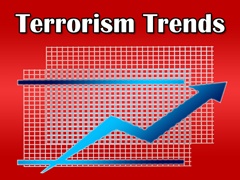 If it seems as though terrorism has been on the rise these past few years, it has. Terror attacks have spread to more countries than ever and innocent, private citizens are increasingly becoming targets. When terrorism strikes, it undeniably leaves a lasting impact on the nation and its people.
If it seems as though terrorism has been on the rise these past few years, it has. Terror attacks have spread to more countries than ever and innocent, private citizens are increasingly becoming targets. When terrorism strikes, it undeniably leaves a lasting impact on the nation and its people.
In the third edition of the Global Terrorism Index for 2015, the Institute for Economics and Peace (IEP) collected data from the Global Terrorism Database to determine key global trends and patterns in terrorism over the past 15 years, with an emphasis on 2014. Let’s take a look at these global terrorism trends, facts, and figures.
Global Terrorism Trends, Facts, & Figures
- Terrorist activity continues to rise. In 2014, the total number of deaths from terrorism reached 32,685 – up 80 percent compared to 2013. This was the largest year-on-year increase. Since 2000, deaths from terrorist activities have increased nine-fold.
- More countries are experiencing terrorist attacks than before. Attacks were recorded in 93 countries for 2014, an increase from the previous year. Of those, 67 countries experienced one or more deaths from terrorist activity.
- More countries than ever have high levels of terrorism. As of 2014, 11 countries are suffering from 500+ terrorism deaths.
- Private citizens are increasingly becoming targets of terror attacks. Deaths of private citizens increased 172 percent between 2013 and 2014. In comparison, terror attacks on religious targets decreased 11 percent for the same timeframe.
- Terrorism remains highly concentrated in five countries. Iraq, Nigeria, Afghanistan, Pakistan, and Syria accounted for 57 percent of all terror attacks and 78 percent of all lives lost in 2014. These top five countries were named most affected by terrorism in 2012 and 2013 as well.
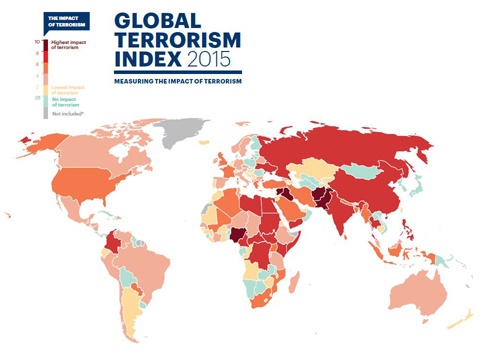
- Two groups are responsible for half of the deaths from terrorism. 51 percent of deaths from terrorism were attributed to Boko Haram and ISIL alone. Boko Haram recently overtook ISIL to become the most deadly terrorist group in the world.
- Western countries account for a small percentage of all terror incidents. Since 2000, 4.4 percent of all terrorist incidents have occurred in Western countries (Europe, US, Canada, and Australia). More persistent and severe impacts of terrorism occur in the rest of the world.
- Deaths from terrorism in the west are extremely low. Excluding the September 11th attacks, only 0.5 percent of deaths have occurred in the west since 2000. Including September 11th raises the statistic to 2.6 percent.
- Lone wolf attacks in the west are strikingly prevalent. Lone wolf attacks account for 70 percent of all terrorism deaths in the west from 2006 to 2014. Many lone wolf attacks in the west are attributed to a mixture of right wing extremists, nationalists, anti-government elements, other types of political extremism and supremacism.
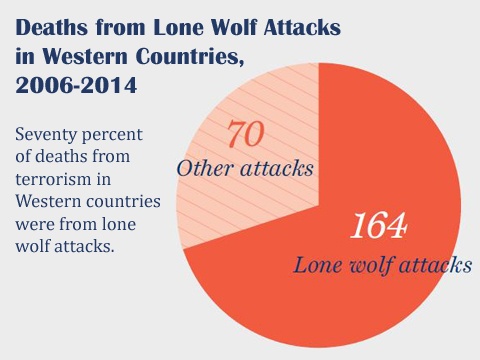
- The flow of foreign fighters into Iraq and Syria continues to be high. Since 2011, between 25,000 and 30,000 fighters from 100 different countries have arrived in Iraq and Syria. Estimates suggest over 7,000 new recruits arrived in just the first half of 2015.
- A majority of foreign fighters come from the Middle East, North Africa, and Europe. 50 percent of all foreign fighters are from Middle-East and North Africa (MENA) while 21 percent are from Europe. 4 percent of foreign fighters come from Turkey alone.
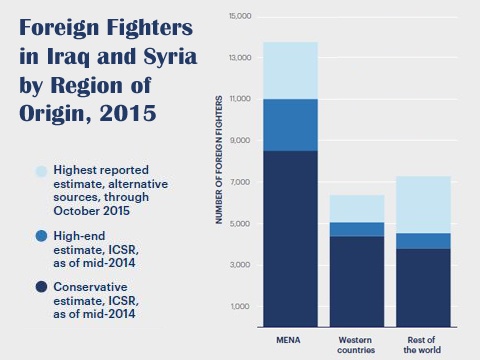
- The global economic costs of terrorism are at its highest level. The economic cost of terrorism increased by 61 percent from 2013 to 2014. At 52.9 billion USD, this is a ten-fold increase since 2000.
- Costs to contain terrorism are greater than the direct costs of terrorism. Estimates suggest the global national security expenditure to be 117 billion USD. National security agencies are tasked with preventing terrorist activity and as well as supporting other elements of national security.
- Terrorist activity is strongly correlated with political violence. 92 percent of all terror attacks between 1989 and 2014 occurred in countries where political violence by the government was widespread.
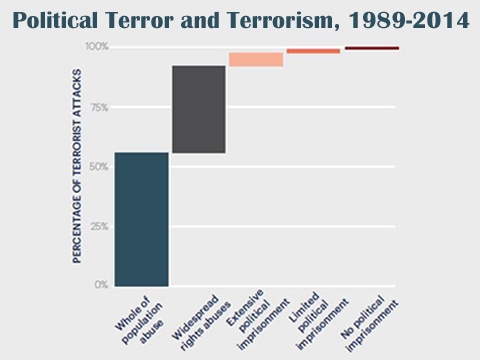
- Drivers of terrorism in wealthier countries differ from poorer countries. For OECD (Organisation for Economic Co-operation and Development) countries, socio-economic factors such as youth unemployment, confidence in the press, faith in democracy, drug crime, and immigration attitudes correlate significantly. In non-OECD countries, factors such as a history of armed conflict, ongoing conflict within the country, corruption, and a weak business environment are strongly correlated.
- OECD and non-OECD countries share common drivers of terrorism. Greater political terror, lower respect for human rights, lower respect for international law (UN and EU), existence of religious freedom policies, group grievances, and political instability all correlate with higher levels of terrorism.
Summary
Tell us what you think about these terrorism trends, facts, and figures in the comments section below. If you would like to learn more about global terrorism, head to:
National Consortium for the Study of Terrorism and Responses to Terrorism’s (START) Global Terrorism Database https://www.start.umd.edu/gtd/
The Institute for Economics and Peace’s (IEP) Global Terrorism Index for 2015 http://economicsandpeace.org/wp-content/uploads/2015/11/Global-Terrorism-Index-2015.pdf



